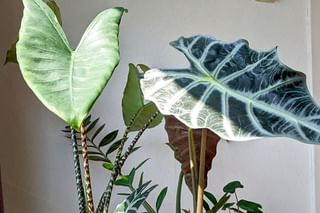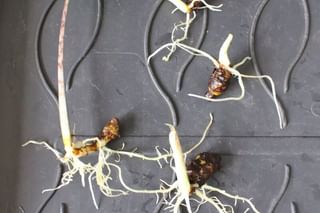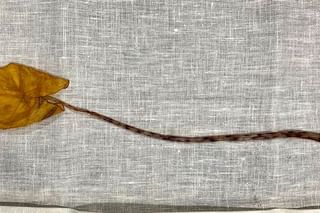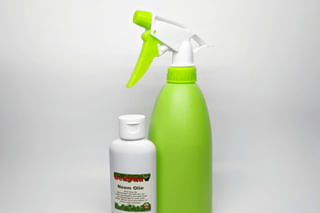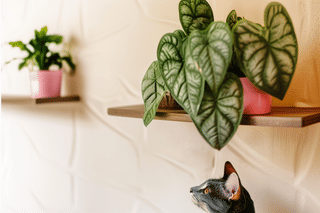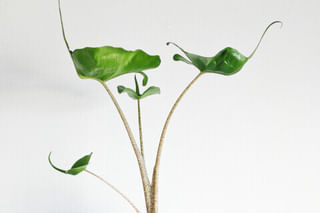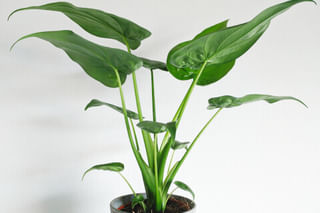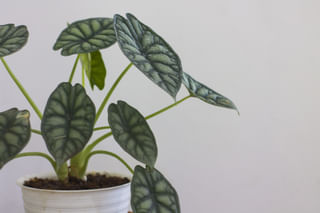How to care for an Alocasia Zebrina
The Alocasia Zebrina is a beautiful plant, but it's not very easy to take care of. In this guide, we'll go over the basics: Light requirements, watering needs, fertilizer, soil, and more. All these tips are written to make it easier for you to take care of your Alocasia Zebrina, even if you're a beginner.
If you're like me, you probably can't resist buying a new houseplant every time you go to the garden center. I'm always looking for interesting plants that I haven't seen before, and when I came across an Alocasia Zebrina at my local nursery, I knew I had to have it.
This exotic-looking plant has dark green leaves with zebra-like patterns on its stems running down the center, and it's sure to add some personality to any room in your home. But before you run out and buy one of these beauties, there are a few things you need to know about how to care for an Alocasia Zebrina. Keep reading for tips on watering, fertilizing, and potting your new houseplant!
In this plant care guide, we'll go over these topics:
Let's get started and learn how to take care of the Alocasia Zebrina!
Humidity and watering

The Alocasia Zebrina is a tropical plant, which means it needs a humid environment. If it gets too dry, it'll become vulnerable to pests.
Luckily, there is a very simple way to keep this plant humid enough: mist it occasionally. It's best to do this at least once per week in the morning. By misting your Alocasia Zebrina, you also prevent the leaves from becoming dusty. It makes your plant look healthier and it'll be happier with the added humidity.
When should I water my Alocasia Zebrina?
This plant loves a humid climate, but that doesn't mean it likes to be watered a lot. It's better to underwater this plant slightly. Its thick stems contain a lot of moisture, so you won't need to water it as often as you would expect.
The long stems will store a lot of moisture, which means it's quite easy to see when your plant is thirsty. When all stems start to droop slightly, their stems are no longer full of moisture and your Zebrina needs to be watered.
If only a single stem starts to droop, don't water your plant. A single drooping stem could mean that your plant is trying to replace it with a new leaf.
How do I water an Alocasia Zebrina?
A simple trick you can use when watering this plant is to water it until water starts to drip out of the drainage hole. When the water drips out of the drainage hole, the soil has gotten enough water and can't absorb anymore. Draining the excess water is important to prevent root rot. The Alocasia Zebrina doesn't like to sit in wet soil and this will cause root rot quite quickly.
Nursery pot inside of a pot without drainage holes
If you don't have a pot with a drainage hole, you can use the plastic pot it came in and place it inside of the "permanent" pot. You can see this in the image above. Now, when you want to water your Alocasia Zebrina, you can lift out the nursery pot and put it in a sink.
With these 2 pots, you can water your plant, drain the excess water, and put it back into its pot without drainage holes. If this is also not an option for you, simply water it more often, but only in very small quantities. The goal is to keep the soil slightly damp, but not so much that your Alocasia sits in wet soil.
Checking if the plant needs water
For a lot of plants, you can simply touch the soil and if it feels dry, you can water it. This is not the case for this plant. This Alocasia is very sensitive to water. The best way to determine if it needs a drink (besides the drooping stems), is to lift the pot, and if it feels light, water it. This could take some practice. So when you see your plant drooping, don't water it immediately, but lift it first. Now you can tell what its "dry" weight is for the next time.
How much sunlight does an Alocasia Zebrina need?
The Alocasia Zebrina needs a lot of sunlight. I have it in a room with a south-facing window, so it gets a lot of sun during the day. Don't put it right next to the window though, this will burn its beautiful, big leaves. If your plant gets slightly yellow leaves, you know the sun was too much for the plant and you'll need to move it to a shadier spot. If you don't have a room with a south-facing window, that's no problem! You can also place it next to the west or east-facing window.
These rooms won't get as much sun, but by placing the plant right next to the window, it'll still be enough throughout the day.
Rotating the plant
This plant craves sunlight, even to such an extent that if you don't give it enough, it'll become leggy (stretch its stems) and grow towards the light.
If you don't pay enough attention to this, the plant will grow to one side, instead of up. A simple solution to prevent this "reaching for the light" is to rotate this plant 90 degrees after every time you water it. If your plant is not reaching for the sun, you don't have to do anything, your plant is happy with its spot.
What is the ideal temperature range for an Alocasia Zebrina?
The ideal temperature range for an Alocasia Zebrina is between 18 to 25 degrees Celsius (64 to 77 F). This tropical plant thrives in warm environments and is sensitive to sudden temperature changes and cold drafts. These can harm the plant, so maintaining a consistent temperature within this range will help to keep the plant healthy.
What is the best type of soil for an Alocasia Zebrina?
The soil choice is important when taking care of the Alocasia Zebrina. As I mentioned earlier in this guide, this plant should be slightly underwatered rather than overwatered, because overwatering could kill it.
A way to lower the chances of overwatering is by using very well-draining soil. This will drain all excess water from the pot and only the minimum required water stays behind. As this plant is susceptible to overwatering, this is perfect. It can only absorb a minimal amount of water and its roots won't be at risk of rotting as easily.
Leca
Alocasia Zebrina plants can also be grown in another medium, Leca. Here you can find everything you need for growing your Alocasia Zebrina in Leca.
How often should I fertilize an Alocasia Zebrina?
The Alocasia Zebrina grows quickly in its growing period from spring until early autumn/fall. During this time, you should fertilize the plant every two weeks to give it the energy it needs to keep growing so quickly.
Always make sure you flush the remnants of the fertilizer out every few months. You can do this by watering the plant thoroughly and letting the water drain through the bottom of the pot. This will keep the soil a habitable place for your plant.
Pruning and Grooming tips for Alocasia Zebrina
To keep your Alocasia Zebrina looking good and healthy, you need to get into pruning. It's not just about making the plant look pretty. Pruning is about keeping your Alocasia healthy by getting rid of damaged or dead leaves, which helps ward off pests and diseases.
Grab some sharp, clean scissors or pruning shears to do the job without hurting the plant or bringing in any pests. You want to snip right near the main stem but be careful not to cut into it. The nice thing about Alocasia Zebrina is that it doesn't need a ton of pruning. It naturally drops its older leaves to make room for new ones.
During winter, it's normal for some leaves to die off. This is just the plant's way of preparing for new growth in the spring. Clearing away the dead leaves keeps things tidy and makes room for the new leaves to shine. If you have to trim your Alocasia, try to never remove more than about a third of the plant. As pruning more, could put the plant into shock.
The best time to prune is in spring or summer when it's growing actively. This way, your Alocasia Zebrina bounces back fast and sprouts new growth in no time.
Can Alocasia Zebrina be propagated?
Alocasia Zebrina can be propagated quite easily. You can propagate these amazing plants through either division or the harvesting and growing of corms, which are essentially underground plant stems. When you're propagating your Alocasia Zebrina it's important to provide it with the right conditions, such as adequate moisture, warmth, and light, to encourage successful propagation.
Take a look at this guide for more info on which propagation method is best: How to propagate an Alocasia Zebrina.
What is the best pot size for an Alocasia Zebrina?
The Alocasia Zebrina loves to be root-bound in a small pot. So don't repot this plant in a larger pot too quickly. It's very happy to be in a small pot. When you eventually do have to move this plant to a bigger pot, make sure to do this in small steps. You want the Alocasia to settle in a slightly bigger pot quickly to keep it happy. When you see the roots start to come out of the bottom of the pot, you know your Zebrina is a happy plant.
For more help and info on repotting your Alocasia Zebrina, check out this guide: How to repot an Alocasia Zebrina.
Alocasia Zebrina Character traits
Every plant has its character traits, like growing flowers. The Alocasia Zebrina also has a few character traits that look worse than they are. This section is to help you understand why your plant does what it does and why you shouldn't blame yourself for things your plant naturally does.
Dropping leaves
When an Alocasia Zebrina is growing, it will put out quite a few leaves in a short period. Until a certain point, this does not affect the plant at all. Once your plant has about 5 leaves, it'll start to drop the weakest leaves spectacularly. The image below is what this looks like.
The plant cuts off the nutrients to the weakest leaves to preserve them for new growth. A single plant can only keep about 4-5 leaves at once and when new leaves are being grown, the old and weak ones will die. There is nothing wrong with this, this is how the plant naturally behaves. There is no way to save the leaf and you should see it as a good sign that there are new leaves on the way.
Sweating leaves
When you take care of your Alocasia Zebrina, you might have seen water drops on the leaves before. These appear when your plant is a little overwatered and it's trying to "sweat" the excess water off by letting it escape from tiny pores in the leaves. This is no reason for concern, the plant is fine. However, it's good to keep in mind for watering your plants next time.
Common problems and diseases that affect Alocasia Zebrina

Alocasia Zebrina can run into a bunch of common issues and diseases that will try to harm this plant. In this section, we'll look at these problems together and figure out how to help your Alocasia recover from them.
Spider Mites
These tiny pests are a common problem for Alocasia Zebrina. They suck the sap from the leaves and cause damage. Keeping the humidity high around your plant can deter spider mites, as they thrive in dry conditions. Regularly wiping down the plant's leaves is a great first step to control an infestation. For more information, have a look at my spider mite guide: How to get rid of spider mites on your houseplants.
Fungus Gnats
Fungas Gnats, at least the adult flies, are not harmful to your plant. When you notice these bugs are flying around your plant, you know your plant is probably dealing with root rot. These flies lay their larvae in the wet soil. These larvae feed on the organic matter, including the roots of your plants. So while the adult flies are not harmful to your plant, their larvae are.
To manage and prevent fungus gnat infestations, it's important to allow the soil to dry out between waterings, as they love to use wet soil as an ideal breeding ground. You can also use a layer of sand or gravel on top of the soil to discourage adult gnats from laying eggs in the first place.
Mealybugs
These pests can quickly weaken your plant by feeding on its sap. Mealybugs often hide in the nooks and crannies of Alocasia Zebrina plants, making them hard to spot in the early stages of infestation. To fight these pests, dabbing them with a cotton swab soaked in alcohol can be effective, as can using insecticidal soap or neem oil treatments. Good air circulation around your plants also helps prevent mealybugs by making the environment less hospitable for them.
Root Rot
Root rot usually happens when you're a bit too generous with watering and the plant's roots end up soaking in moisture for too long. If you've got root rot on your hands, try watering less often, double-check that your pot lets water out well, and you might even need to give your plant a fresh start in new soil.
If you choose to repot your plant into fresh soil, make sure to trim any rotting roots. Rotting roots will be soft, mushy, and brown/black.
Leaf Spot Disease
Leaf spot disease can be caused by both bacterial and fungal infections, leading to unsightly spots on the leaves. Improving air circulation around the plant, avoiding wetting the foliage when watering, and removing affected leaves can help manage leaf spot disease.
Yellowing Leaves
If the leaves of your Alocasia have started to turn yellow, it could mean overwatering, a lack of nutrients, or too much sunlight. The first thing you should try is to look at your watering schedule and only after you know that's going well should you change your fertilizing schedule. You don't want to accidentally overfertilize your plant if you've been watering it too much.
Powdery Mildew & Southern Blight
These fungal diseases can also affect Alocasia Zebrina. Powdery mildew looks like white powdery spots and southern blight looks like a white, web-like growth around the base of the plant. You can prevent these diseases by providing good airflow and reducing the humidity around your Alocasia. If these fungal infections are getting more serious, it's a good idea to use fungicidal products.
How do I prevent pests on my Alocasia Zebrina?
In the previous section, we've learned that the Alocasia Zebrina is susceptible to quite a few pests. But do you know how you can prevent these from showing up on your plant in the first place? Let's find out!
Regular inspections
By far, the easiest way to prevent pests from getting out of hand on your Alocasia Zebrina is to regularly check your plant for any pests. They can be hard to spot, so take your time and look closely. Most pests like to hide on the undersides of leaves and stems or in hard-to-reach places, so be sure to check the whole plant.
The right growing environment
Make sure your plant's growing conditions are ideal: proper light, humidity, and airflow can reduce stress and make your plant less susceptible to pests. When your plant is happy, it's strong and much more likely to fight off pests by itself. Sick or weakened plants are the easiest targets for pests, so by keeping them strong, you keep pests away more easily.
Neem oil treatment
Neem oil is a natural pesticide that can be effective in preventing and treating infestations of mealybugs, spider mites, and more. Use it as a preventative measure or at the first sign of trouble. You can do this by regularly spraying your plant with the neem oil mixture. This makes the plant offputting for pests but also gives your plant a nice shine. Win-win!
Is the Alocasia Zebrina toxic to pets?
Like many other tropical plants, Alocasia Zebrina is poisonous when ingested and the sap from its stem can irritate your skin. So it's best to keep this plant out of reach from small children and pets. This way you can enjoy this plant to the fullest and it will look the most beautiful in the long run.
How large does an Alocasia Zebrina get?
Alocasia Zebrinas can range quite a bit in size, from small plants grown from bulbs to large mature plants that are as tall as 1 meter (3 feet). Other plants in the Alocasia family can get much bigger, but the Alocasia Zebrina stays small enough to be the perfect houseplant.
Seasonal care for Alocasia Zebrina
Looking after your Alocasia Zebrina means changing up its care as the seasons turn, just like in its natural home. If you tweak how you care for it throughout the year, you'll keep it happy and healthy all the time.
Spring/Summer
During the growing season, which includes spring and summer, your Alocasia Zebrina will be in its active growth phase. It's important to fertilize the plant every two weeks with diluted liquid fertilizer to provide the necessary nutrients for growth.
This is also the time to make sure that your plant receives consistent moisture, filtered light, and warm temperatures to encourage healthy growth. With the higher temperature, you may need to water your Alocasia Zebrina more often. Also, try to keep the plant from being in an environment over 25 degrees Celsius (77 F) and away from air-conditioning units as the temperature change can shock the plant.
Autumn (Fall)
As the seasons turn into autumn/fall, the growth of your Alocasia Zebrina may begin to slow down. This is a natural response to the changing seasons. You should water your plant less often and stop fertilizing it. However, it's important to maintain the higher humidity levels around your plant. You can do this by placing your plant on a tray of wet pebbles or by using a humidifier.
Winter
When winter arrives, your Alocasia Zebrina may enter a dormant phase, especially if it gets cold. During dormancy, your Alocasia won't need a lot of water and won't need any fertilizer. This means you'll need to water your plant even less because it's quite easy to overwater your plant during this time. The same goes for fertilizer: it's easy to overfertilize your plant, so it's best to wait for spring to feed your plant again.
During the dormancy period, you should still provide your plant with stable temperatures within the ideal range of 18 to 25 degrees Celsius (64 to 77 F), and avoid placing the plant near heating or cooling vents can prevent shock from the temperature changes.
Winter is usually quite dark, so you might have to give your Alocasia Zebrina some extra sunlight by moving it to the brightest spot in your house. The weak winter sun won't harm your plant. You can also choose to use growing lamps.
Growing an Alocasia Zebrina outdoors

If you'd like to move your Alocasia Zebrina outdoors at some point, you might be in luck! You can grow this amazing plant outdoors, but it does have a few specific requirements to thrive in an outdoor environment. If you live in USDA zones 10 and 11, you can grow this plant outside year-round, but if not, you might be limited to only keeping it outside in the summer.
Here are the key requirements and considerations for growing Alocasia Zebrina outdoors:
Climate
Alocasia Zebrina thrives in warm, humid climates similar to its natural tropical environment. If you live in a region with cold winters, you can only grow this plant outside in the summer. It's not a plant that can survive in the frost.
Lighting
While the Alocasia Zebrina loves plenty of light, direct sunlight can scorch its leaves. So if you're planning on moving it outside, make sure to find a spot with bright filtered light, or bright indirect sunlight, to protect it from direct sunlight. A semi-shaded spot that receives filtered sunlight throughout the day is ideal.
Watering
The soil should stay consistently moist but not waterlogged. Proper drainage is very important to prevent root rot. When they're growing outdoors, you might need to water them a little more often during the hot and dry periods. If it's raining a lot, you have to use a pot with a drainage hole to prevent drowning your plant.
Humidity
Alocasia Zebrina loves high humidity levels, ideally between 70 percent or more. In drier climates, creating a microclimate or providing additional humidity through misting or being close to a pond can keep the humidity levels a little higher.
Protection from the elements
The Alocasia Zebrina can adapt to many environments, but sudden changes in temperature, strong winds, or heavy rain can damage the plant. Consider putting it in a location that gives it some protection from harsh weather conditions.
Acclimating an Alocasia Zebrina to a new environment
In the previous section, I mentioned that the Alocasia Zebrina doesn't do too well with sudden changes in temperature and humidity, so if you want to move your plant, either to a new spot in your home or outside, you'll need to do so gradually.
But how do you do this? Let's go over the steps to move your plant to a new spot!
Step 1: Start with light
When you start to move your plant, make sure to give your plant plenty of bright indirect sunlight. Avoid direct sunlight as it can scorch the leaves. If moving the plant outdoors, start with a shaded area and gradually increase its exposure to light over a week or two to prevent stress.
Step 2: Keep the humidity & temperature the same
While you take care of the sunlight, make sure to keep a close eye on the humidity and temperature. Ideally, you'll want to have the same levels on the current and the new spot. If that's not possible, you can gradually increase or decrease the temperature with sunlight.
The same goes for humidity: Use a humidifier, mist your plant, or use a dehumidifier to gradually let your plant get used to the new spot over 2 weeks.
Step 3: Slowly start to water more or less
When you move your plant, you'll want to keep a closer look at the moisture in the soil. The new spot could mean that you'll have to water your Alocasia more or less. It's best to check your plant every 1-2 days after you've moved it to find out how often you should water it.
Step 4: Leave your plant alone
After you've moved your plant, you have to leave it alone. You've already done everything you can to make the transition as easy as possible for the plant, but it could still show some signs of stress, such as drooping leaves or discoloration. It might shed some leaves as it adjusts, this is all normal.
You need to let the plant get used to the situation, which could take a few weeks. Whatever you do, don't move or handle it for these few weeks. You might stress the plant out more and this could put it at risk of pests or diseases.
Just make sure to water the plant when it needs it, fertilize it regularly, and that's it.
Other Alocasias with similar care
Several other Alocasias require similar care to the Alocasia Zebrina. So if you have one of the following Alocasia plants, you can use this guide to take care of your Alocasia as well.
Alocasia Stingray
The Alocasia Stringray looks a little bit like the Alocasia Zebrina. The stems store moisture just like the Alocasia Zebrina and have very similar sunlight requirements to the Alocasia Zebrina.
Alocasia cucullata
The Alocasia Cucullata looks different than the other Alocasias, but it still has the big stems that store all that moisture. That's why it can go quite a while without being watered.
Alocasia Silver Dragon
The Alocasia Silver Dragon requires similar care to the Alocasia Zebrina, particularly in its need for a well-draining soil mix to avoid overwatering. However, it may demand slightly less water than the Zebrina, making it somewhat easier to care for in terms of watering frequency.
Companion plants for Alocasia Zebrina
Pairing Alocasia Zebrina with other plants can improve your garden or indoor plant scene. As we saw earlier, it gets along best with other Alocasia types. But there's also this one plant that makes a great match with Alocasia Zebrina, giving your space a tropical feeling.
Caladiums
Caladiums, with their eye-catching leaves in all sorts of colors and patterns, go hand in hand with Alocasia Zebrina's looks and they have very similar care requirements. Putting them together is a great move if you're aiming for that lush, tropical feel.
Placing these plants together doesn't just look great, but it also helps to stabilize the humidity levels around the plants: They create a micro greenhouse effect around them.
Conclusion
The Alocasia Zebrina, with its distinctive striped stems and lush foliage, is a captivating addition to any indoor or outdoor garden. By following these care practices, including managing light exposure, watering, humidity and temperature, fertilization, soil, and pest and disease management, you can create the ideal environment for your Alocasia Zebrina to flourish.
Not only will these practices encourage growth and potential flowering, but they will also enhance the overall health and longevity of the plant. Also, incorporating companion plants like Caladiums or other Alocasias can elevate the aesthetic of your space and promote a thriving plant community. With patience and attention to your Alocasia Zebrina's needs, you can enjoy the beauty and vibrancy it adds to your plant collection for years to come!
Thank you for reading this post! I hope it helps you to keep your plants healthy and beautiful! If you're looking for more guides on specific plants, you can always request a plant guide to get a guide for the plant you have trouble with.
Test your plant care knowledge
Quiz completed!
Want to learn more? Sign up for my newsletter to receive free tips in your inbox!
Sign up now!

